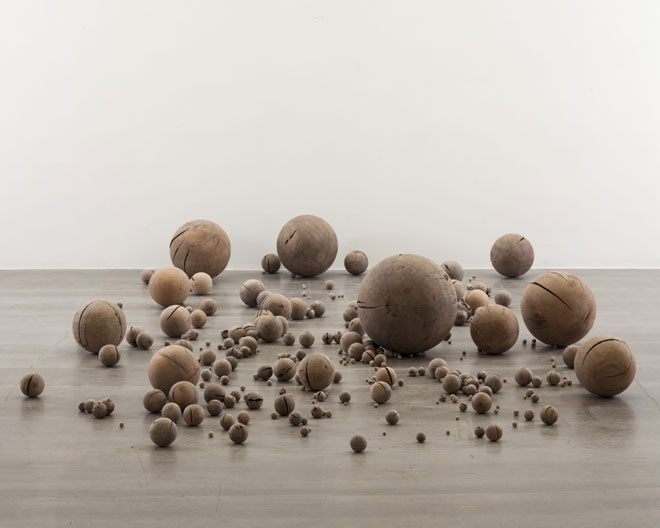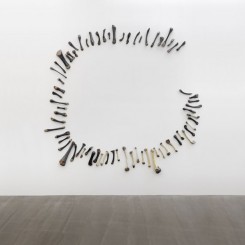Galerie Urs Meile (No. 104 Caochangdi, Chaoyang District, 100015 Beijing, China) Mar 2 – Apr 28, 2013
The gap between “method” and “methodology” is a wide one. Whilst the first describes a distinct path through a given problem, the second bleeds through its additional letters into the realm of philosophy, “underlying principles” and uncertain outcomes — and is far more often pinned to artistic practice. Asserted for Li Gang around his current solo exhibition is a personal “methodology” set apart from the mainstream fixation with youth as a source of value.
But what is it that this artist considers “valuable” for his work? What has guided the process for this select group of pieces? There are four paintings and three sculptures on show, all made last year. The paintings are done on extremely heavy canvases woven visibly from broad strands of hemp, making their surfaces heavily corrugated; one is merely painted white, but the other three take elements of historic Western works and blow them up to huge proportions, so that what has actually been depicted is confirmed only by their titles (“Big Moustache,” “Face,” and “Green Vase”). “Ridge” is a broken circular arrangement on the wall of what look like bones, but are in fact large pebbles fused together with a limb of hardened glue. “Beads” has taken the joints from an ancient tree in South China and fashioned them into spheres of different sizes, now artistically arranged on the floor. “Mouse Hole” is an odd pyramid-like assemblage of wooden frames leading up to a gash kicked in the gallery wall.

Li Gang, “Beads,” wooden spheres,shaped from the connecting points of a dead tree of Yunnan Province, 397 pcs., ø 0.5 – ø 51 cm, 2012 (Galerie Urs Meile, Beijing-Lucerne)
One detects an existential seam, both from the suggestion in the work’s caption that the wooden “Beads” be a metaphor for the progress of life (to which a pleasant idea of their rolling about, pushed by different forces, attaches itself), and in the stone/bone sculpture which at the simplest level implies the relationship between natural matter, history and pattern. The works on hemp canvas are most obviously addressed to the nature of the surface itself and the transmission of artistic images. There is a ready enjoyment of materials conveyed here, too, and Li Gang is not the first Southern Chinese artists to have been compelled to work with ancient wood, creating something new from its textured boughs.
At the same time, however, these pieces feel less adroit than did a work like “Pedestal” (2012) – the series of wooden plinths against which banknotes had been wiped to create a taut rash of monetary skid-marks, or “The Construction of the Image” (2012), for which oil paint was applied then removed and put in an acrylic vitrine in front of the denuded canvas. The current exhibition by Li Gang, despite the “Edge” in its title, seems to want that of these other works. But the appreciation of art always hovers between the desires of artist and onlookers – realized or unconscious, a virtue may be made of ambivalent “methodology”. With these thoughts in mind, one is inclined still to await the effect of these new works, and their place in the broader picture of Li’s practice.
